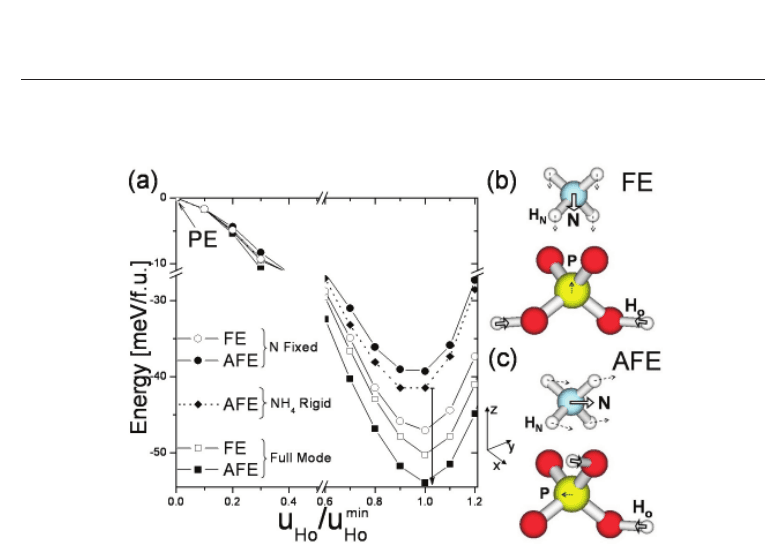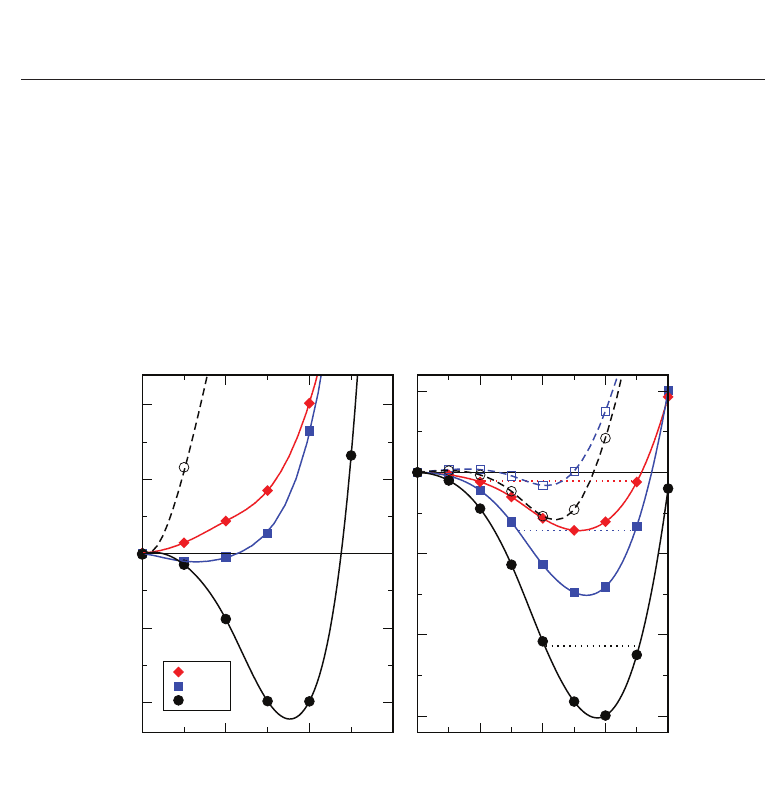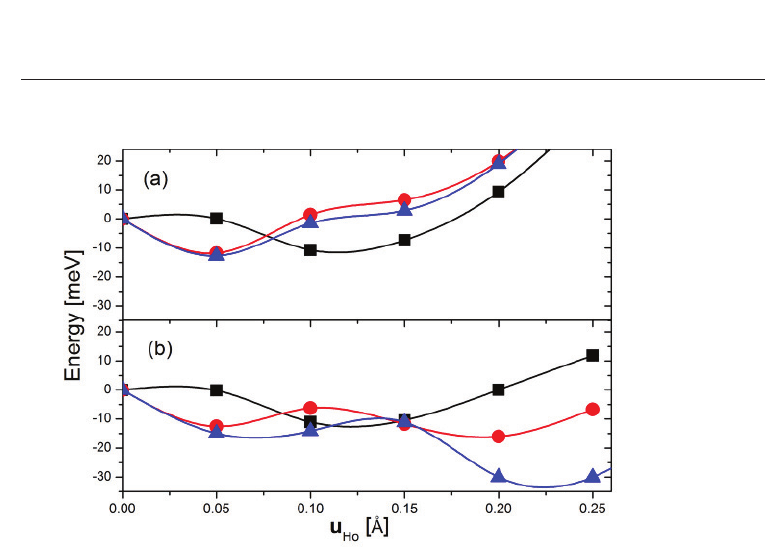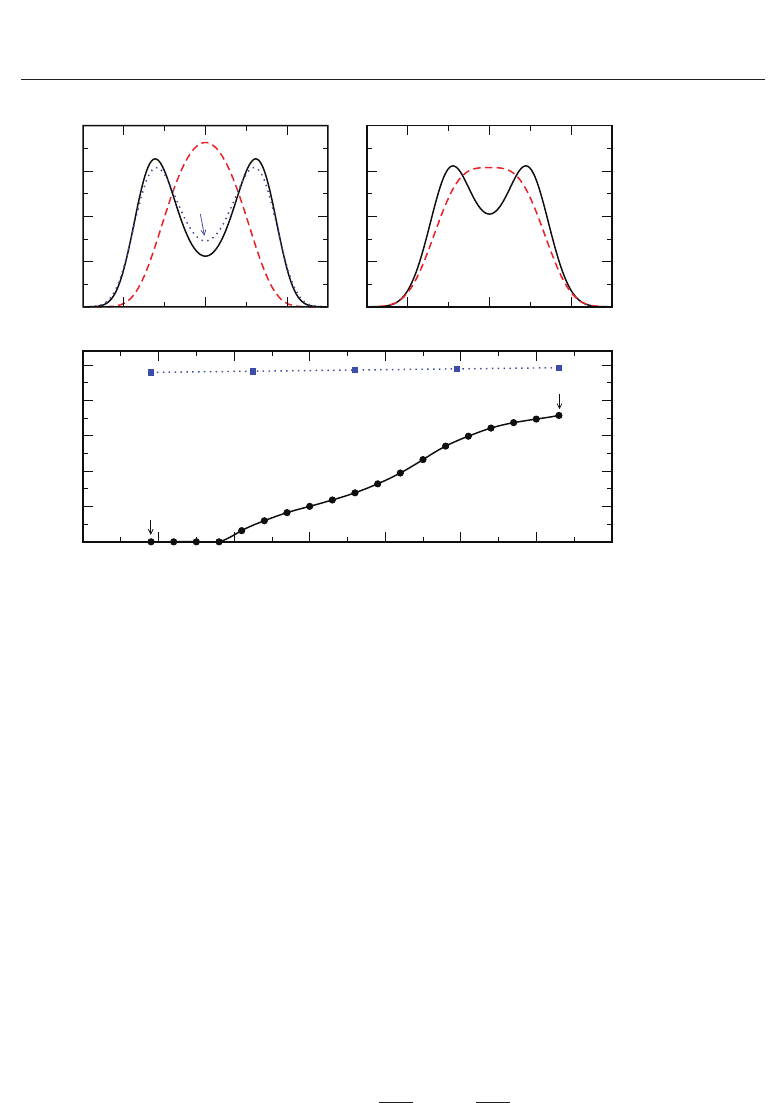Lallart M. Ferroelectrics: Characterization and Modeling
Подождите немного. Документ загружается.


Ab Initio Studies of H-bonded Systems: the Cases of Ferroelectric KH
2
PO
4
and Antiferroelectric NH
4
H
2
PO
4
9
PE AFE(ADP) FE(KDP)
Structural ADP KDP
parameters AI Exp AI Exp
c
AI Exp
a
AI Exp
c
a - 7.473
a
- 7.426 - 7.503 - 10.546
b
- 7.473
a
- 7.426 - 7.512 - 10.466
c
- 7.542
a
- 6.931 - 7.488 - 6.926
d(O-O)
- 2.481
a
2.407 2.483 2.462 2.50 2.446 2.497
d(O
2
-H
O
) 1.240 1.049
b
1.204 1.071 1.093 0.90 1.108 1.056
δ
0 0.377
b
0 0.341 0.277 0.70 0.230 0.385
d(P-O
1
) 1.541 1.538
b
1.592 1.543 1.572 1.522 1.572 1.516
d(P-O
2
) 1.541 1.538
b
1.592 1.543 1.618 1.566 1.618 1.579
<O
1
-P-O
1
108.6 108.6
b
108.6 110.6 111.7 112.5 114.5 114.6
<O
2
-P-O
2
108.6 108.6
b
108.6 110.6 104.6 104.7 107.6 106.7
<O
1
···H-O
2
180.0 177.1
b
176.6 178.2 175.3 - 176.8 179.4
d(N-H
1
N
) 1.048 1.002
b
--1.052 0.90 --
d(N-H
2
N
) 1.048 1.002
b
--1.042 0.83 --
d(N-O
1
) 3.170 3.172
b
--3.139 3.152 --
d(N-O
2
) 3.170 3.172
b
--3.182 3.152 --
d(N-H
1
N
...O
1
) 2.895 - --2.779 - --
d(N-H
2
N
...O
2
) 2.895 - --2.923 - --
Table 1. Comparison of the ab initio (AI) calculated internal structure parameters of KDP and
ADP (Ref.(60)) with experimental data for the PE, AFE(ADP) and FE(KDP) phases
considered in the text. Distances in Å and angles in degrees.
a
Ref. (65);
b
Ref. (66);
c
Ref. (61)
in these systems. (21; 46; 48) Thus, when the protons displace off-center and approach the O
2
atom, the charge localizes mostly in the O
1
atom and to a lesser extent in the O
1
-P orbitals.
This is accompanied by a weakening of the O
1
···H bond and a strengthening of the O
1
-P
bond, which shortens (see Table 1). On the other hand, the charge flows away from the O
2
atom and the O
2
-P bond and localizes mostly in the O
2
-H bond which strengthens. Then,
the PO
4
tetrahedron distortion as observed in Table 1 is a consequence of the strengthening
and weakening of the O
1
-P and O
2
-P bonds respectively, as the protons displace off-center
in the H-bonds. The overall effect of the acid H’s off-centering in the PO
4
+ acid H-bond
subsystem of ADP and KDP can be summarized as a flow of electronic charge from the O
2
side of the phosphate tetrahedron towards the O
1
side with a concomitant modification of
its internal geometry. Thus, the charge redistributions results for the acid H-bonds shown in
Table 2 enable us to conclude that the behavior for these bonds in both compounds are very
similar. (21; 46; 48) A schematic view of the displacements of the atoms along the FE mode in
KDP and the accompanying electronic charge redistributions produced upon off-centering of
the H-atoms is shown in Fig. 2.
We have also compared in ADP the behavior of the N-H
···O bonds between oxygen and
ammonium in the AFE phase with that in the hypothetical FE one (See the schematic lateral
view in Fig. 3(b)).(60) To this aim, we computed the changes in the Mulliken orbital
and bond-overlap populations for these bonds in going from the PE to the AFE and FE
configurations. The results are shown in Table 3. When the acid H’s are displaced with the
FE pattern of Fig. 3 (b), all H
N
’s remain equivalent and the O···H
N
bonds weaken. This
419
Ab Initio Studies of H-Bonded Systems:
The Cases of Ferroelectric KH
2
PO
4
and Antiferroelectric NH
4
H
2
PO
4

10 Will-be-set-by-IN-TECH
Phase O
1
O
2
PHO
1
-P O
2
-P O
1
··· HO
2
-H K
FE(KDP) +82 -58 -8 -17 +46 -44 -91 +70 -3
AFE(ADP) +100 -151 +5 +35 +44 -33 -98 +91 -
FE(ADP)
+93 -151 +2 +36 +52 -43 -91 +86 -
Table 2.
Changes Δq = q(x) − q(PE) (x = AFE,FE for ADP or FE for KDP) in the Mulliken orbital and
bond overlap populations in going from the PE to the AFE and FE phases in ADP (60) or to the FE phase
in KDP (48). Shown are populations of the atoms and bonds belonging to the phosphates and the
O-H
···O bridges in both compounds. Also reported is the result for the K atom in KDP. Units in e/1000.
Phase NH
2
N
H
1
N
N-H
1
N
N-H
2
N
O
1
··· H
1
N
O
2
··· H
2
N
AFE +7 +7 -9 -4 +4 +16 -14
FE
+1 +1 +1 +3 +3 -7 -7
Table 3.
Changes Δq = q(x) − q(PE) (x = AFE or FE) in the Mulliken orbital and bond overlap
populations in going from the PE to the AFE and FE phases in ADP (60). Shown are populations of the
atoms and bonds belonging to the NH
+
4
ions and the N-H···O bridges . Units in e/1000.
behavior is compatible with the decrease in the bond overlap population for this bond in
Table 3. On the contrary, with the AFE distortion (see Fig. 3(c)), the arising short and long
N-H
···O bonds behave in an opposite way. In fact, the long N-H
2
N
···O
2
bond suffers a
decrease in the O
2
···H
2
N
bond overlap population and a weakening of the bond while the
corresponding magnitude of the short N-H
1
N
···O
1
bond increases and the bond strengthens.
The charge variations are observed to be nearly twice the corresponding value for the
analogue magnitude in the FE phase. Similarly, in the AFE phase the N-H
2
N
bond strengthens
with a slight increment in the bond overlap population and the N-H
1
N
bond weakens with a
decrease in the localized charge. These charge redistributions in the ammonium tetrahedron
give rise to its distortion (see Table 1). As a consequence, we observe a charge flow from the
long to the short N-H
···O bonds which is concomitant to the ammonium distortion, absent in
the FE phase.(60) This behavior is also observed in charge density difference plots for ADP.(21)
In the next Section we discuss how the charge flow inside ammonium and its distortion are
related to the stabilization of the AFE phase over the FE one in ADP.(21)
3.3 Origin of antiferroelectricity in ADP
With the aim of studying the AFE and FE instabilities and their relative importance in ADP,
we have performed different calculations.(21) First we consider the joint displacement of N
andacidH
O
protons from their centered positions in the PE phase, denoted by u
N
and u
H
O
respectively. These are performed in two cases: (i) following the AFE pattern of distortion (see
Fig. 3(c)), and (ii) following the FE pattern (see Fig. 3(b)). The H
N
’s of the ammonium and
P’s are allowed to relax (this is always the case unless we state the contrary), while the O’s
remain fixed for the reasons explained in Subsection 3.1. The ab-initio total-energy curve is
plotted in Fig. 3(a) as a function of u
H
O
, for the concerted motion of H
O
and N corresponding
to each pattern. We observe that the calculated minimum-energy AFE state is only slightly
more stable than the FE counterpart, with a small energy difference of 3.6 meV/f.u. (f.u. =
formula unit). With the O’s relaxations the AFE state remains 1.25 meV/f.u. below the FE
one. If we additionally relax the lattice parameters according to the symmetries of each phase,
this difference grows to
≈ 3.8 meV/f.u. We have also determined recently the closeness in
energy to the AFE state of two other possible ordered phases with translational symmetry
and xy-polarized PO
4
tetrahedra.(21) Thus, we confirm the closeness between the AFE and FE
420
Ferroelectrics - Characterization and Modeling

Ab Initio Studies of H-bonded Systems: the Cases of Ferroelectric KH
2
PO
4
and Antiferroelectric NH
4
H
2
PO
4
11
states in ADP, a fact that suports Ishibashi’s model (19; 20) and also provides an explanation
for the coexistence of AFE and FE microregions near the AFE transition.(25; 26)
Fig. 3. (a) Energy as a function of the acid H displacement u
H
O
for different patterns of
atomic displacements corresponding to the FE and AFE distortions depicted in Figs. 3(b) and
3(c) respectively. u
min
H
O
denotes the H
O
displacement at the corresponding energy minimum.
In addition to the full FE or AFE modes, other curves show the effect of imposing different
constraints while performing the FE or AFE modes: N fixed or NH
+
4
moved rigid as in the
PE phase. Lateral views of the ADP formula unit indicate the atomic displacements in the (b)
FE and (c) AFE modes. White arrows correspond to displacements imposed according to
each mode, dashed arrows to accompanying relaxations.
In order to determine the mechanism for the stabilization of the AFE vs FE state, we also
considered the energy contribution of the N and H
O
motion separately.(21) If we set u
H
O
= 0,
a finite displacement u
N
along z (see Fig. 3(b)) does not contribute to any energy instability in
the FE case. Moreover, the N displacement along the xy-plane in the AFE case (see Fig. 3(c))
produces a very tiny instability (less than 1 meV/f.u.). Alternatively, we move the acid H
O
’s
and set u
N
= 0, i.e. N’s are fixed to their positions in the PE phase (see Figs. 3(b) and 3(c)). We
observe in this case a larger energy decrease for the FE pattern compared to the AFE one (see
circles in Fig. 3(a)). It is worth mentioning that here the H
N
’s relaxations in the ammonium
are very small in contrast with the case where both N and H
O
’s are allowed to displace. In
the FE case, a further energy decrease of less than 10% of the total instability is achieved
when the N’s are allowed to move together with the H
O
’s (see open circles and squares at the
energy minima in Fig. 3(a)). The fact that the FE-pattern relaxation with u
H
O
= 0 does not
produce any instability prompts us to conclude that the source of the FE instability in ADP
is the acid proton off-centering (u
H
O
= 0), similar to what is found in KDP.(48) The proton
off-centering also produces the AFE instability, but this motion alone is insufficient to explain
antiferroelectricity in ADP.(21)
Finally, we have considered the displacements of all atoms following the pattern of the AFE
mode, with the only constraint that the structure of the NH
+
4
groups is kept rigidly symmetric
421
Ab Initio Studies of H-Bonded Systems:
The Cases of Ferroelectric KH
2
PO
4
and Antiferroelectric NH
4
H
2
PO
4

12 Will-be-set-by-IN-TECH
as in the PE phase.(21) The energies obtained in this case are shown by solid diamonds in
Fig. 3(a), which have to be compared to those corresponding to the full relaxation of the FE
phase by open squares (in the last case H
N
relaxations in the NH
+
4
groups are negligible).
We observe that the FE state is more stable than the AFE one as long as the NH
+
4
tetrahedra
are not allowed to deform by relaxing their H
N
’s. Notice that by not allowing the relaxation
of the ammonium, this ion behaves in the same way as the K
+
ion in KDP, where the FE
phase is more stable than the AFE distortions.(48; 67) If we allow for the optimization of the
N-H
···ObridgesbyrelaxingtheNH
+
4
, the stabilization of the AFE state against the FE one is
achieved. This energy decrease is visualized in Fig. 3(a) by the arrow between full diamonds
and squares at u
H
O
/u
min
H
O
= 1. Therefore, the origin of antiferroelectricity in ADP is ascribed
to the optimal formation of N-H
···O bridges.(21) This conclusion is further supported by
a study of the energy variation produced by a global rigid rotation of the NH
+
4
molecules
around the z-axis.(21)
3.4 Local instabilities and the nature of the PE phases of KDP and ADP
The observed proton double-occupancy in the PE phases of KDP and ADP,(38; 61; 62) is
an indication of the order-disorder character of the observed transitions. The origin of this
phenomenon can be ascribed either to static or thermally activated dynamic disorder, or to
tunneling between the two sites. The physics behind these scenarios is intimately connected
to the instabilities of the system with respect to correlated but localized H motions in the PE
phase, including also the possibility of heavy-ions relaxation.
We have analyzed localized distortions by considering increasingly larger clusters embedded
in a host PE matrix of KDP (47; 48) and ADP (60). For the reasons exposed above, the host is
modeled by protons centered between oxygens, and the experimental structural parameters
(including the O-O distances) of KDP and ADP in their PE phases.(61; 65) In order to assess the
effect of the volume increase observed upon deuteration, we also analyzed the analogous case
of D in DKDP by expanding the host structural parameters to the corresponding experimental
values.(47; 48; 61) We also compared qualitatively the effect of volume expansion in ADP
by considering a larger equilibrium O-O distance in the lattice.(60) The trends are compared
qualitatively to the case of KDP, although we have to bear in mind that the instabilites in both
systems have a different character (FE in KDP and AFE in ADP).
First, we considered distortions for clusters comprising N hydrogens (deuteriums) in KDP:
(a) N=1 H(D) atom, (b) N=4 H(D) atoms which connect a PO
4
group to the host, (c) N=7 H(D)
atoms localized around two PO
4
groups, and (d) N=10 H(D) atoms localized around three
PO
4
groups. The correlated motions follow the pattern for the FE mode shown in Fig. 2.
We represented the correlated pattern with a single collective coordinate x whose value
coincides with the H(D) off-center displacement δ/2 (see Fig. 2). Notice that this coordinate is
equivalent to that defined above as u
H
O
for the proton off-centering. For the sake of simplicity,
we considered equal displacements along the direction of the O-O bonds for all the hydrogen
atoms in the cluster. Two cases were considered: (i) first, we imposed displacements only on H
atoms, maintaining all other atoms fixed, (ii) second, we also allowed for the relaxation of the
heavy ions K and P, which follow the ferroelectric mode pattern as expected (Fig. 2). In a next
step, we quantized the cluster motion in the corresponding effective potential to determine the
importance of tunneling in the disordered phase of KDP. Although, rigorously speaking, the
size dependence should be studied for larger clusters than those mentioned here, short-range
422
Ferroelectrics - Characterization and Modeling

Ab Initio Studies of H-bonded Systems: the Cases of Ferroelectric KH
2
PO
4
and Antiferroelectric NH
4
H
2
PO
4
13
quantum fluctuations in the PE phase are sufficiently revealing, especially far away from the
critical point.
We show in Fig. 4(a) and Fig. 4(b) the total ab initio energy as a function of the collective
coordinate x for the clusters considered in KDP and DKDP, respectively.(47; 48) In the case
of KDP, all the clusters considered are stable if only hydrogens are displaced. Actually, the
largest cluster calculated (N=10) is very stable, as indicated by the open circles in Fig. 4(a). In
the expanded lattice of DKDP, results indicate a small barrier of
∼ 6meVfortheN=7move,
and a larger value of
≈ 25 meV for the N=10 cluster (see open squares and circles respectively
in Fig. 4(b)).
0
0.05
0.1
0.15
x [Å]
-10
-5
0
5
10
Energy [meV]
4-H
7-H
10-H
0
0.05
0.1
0.15
0.2
x [Å]
-150
-100
-50
0
50
(a) KDP (b) DKDP
Fig. 4. Energy profiles for correlated local distortions in (a) KDP and (b) DKDP. Reported are
clusters of: 4 H(D) (diamonds), 7 H(D) (squares), and 10 H(D) (circles). Empty symbols and
dashed lines indicate that only the H(D) atoms move. Motions that involve also heavy atoms
(P and K) are represented by filled symbols and solid lines. Negative GS energies signaling
tunneling, are shown by dotted lines. Lines are guide to the eye only.
The energy profiles vary drastically when we allow the heavy atoms relaxations for the above
correlated motions in KDP.(47; 48) Now, clusters involving two or more PO
4
units exhibit
instabilities in both KDP and DKDP. In the case of the N=10 cluster, the barrier in DKDP is
of the order of 150 meV. The appearance of these instabilities provides a measure of the FE
correlation length in the system. In the expanded DKDP lattice, the instabilities are much
stronger, and the correlation length is accordingly shorter than in KDP.
In the next step, we solved the Schrödinger equation for the collective coordinate x for each
cluster in the corresponding effective potentials of Fig. 4.(47; 48) To this aim, we calculated the
effective mass for the local collective motion of the cluster as μ
=
∑
i
m
i
a
2
i
,wherei runs over
423
Ab Initio Studies of H-Bonded Systems:
The Cases of Ferroelectric KH
2
PO
4
and Antiferroelectric NH
4
H
2
PO
4

14 Will-be-set-by-IN-TECH
the displacing atoms and m
i
are their corresponding atomic masses. In this equation, a
i
is the
i-atom displacement at the minimum from its position in the PE phase, relative to the H(D)
displacement.
In the cases where only the N deuteriums are displaced in the unstable clusters of DKDP
(see Fig. 4(b)), all by the same amount, the calculated ground states (GS) energies lie above
the barriers. Thus, tunneling of H (D) alone seems to be precluded as an explanation of the
double site occupancy observed in the PE phases of KDP and DKDP, at least for clusters of up
to 10 hydrogens (deuteriums).(47; 48)
When the heavier atoms are allowed to relax, the effective masses per H(D) calculated for
these correlated motions in different clusters are about μ
H
≈ 2.3 (μ
D
≈ 3.0) proton masses
(m
p
) in KDP (DKDP), respectively. The resulting GS energy levels are quantized below
the barrier for all clusters including the heavy atoms motion in DKDP (see dotted lines in
Fig. 4(b)). Thus, there is a clear sign of tunneling for the correlated D motions involving
also the heavy ions.(47; 48) These collective motions can be understood as a local distortion
reminiscent of the global FE mode. (68) On the other hand, even the largest cluster considered
(N=10) in KDP, has the GS level quantized above the barrier. The critical cluster size where
the onset of tunneling is observed provides a rough indication of the correlation volume:
it comprises more than 10 hydrogens in KDP, but no more than 4 deuteriums in DKDP.
Thus, the dynamics of the order-disorder transition would involve fairly large H(D)-clusters
together with heavy-atom (P and K) displacements. The observed proton double-occupancy
is explained in our calculations by the tunneling of large and heavy clusters.(47; 48) This is
confirmed by the double-site distribution determined experimentally for the P atoms. (69; 70)
In the case of ADP, we have analyzed local cluster distortions embedded in its PE phase.(60)
We considered the experimental lattice in this phase,(65) and in order to vary the O-O
distance, the PO
4
tetrahedra were rotated rigidly. We also let the ammonium relax to optimize
the N-H
···O bridges. We considered displacements of N=1 proton, and also clusters of
N=4 and N=7 simultaneously displaced acid protons from their centered positions in the
H-bonds while keeping fixed the rest of the atoms. In the cases of N=4 and N=7 protons
the displacement patterns correspond to the AFE mode (see Fig. 1(a) and Fig. 3(c)). We
calculated the total energy for each configuration. We plot in Fig. 5 the resulting potential
profiles for the protons along the bridges as a function of their off-center displacements u
H
O
from the middle of the H-bonds. We observe that the off-centering of a single proton leads
to an energy minimum, at variance with the case of KDP.(48; 67) This behavior in ADP has
to be ascribed to the energy contributions of N-H
···O bridges, which compensate the energy
increase due to the formation of Takagi pair defects. The variation of the O-O distance does not
affect this energy minimum, as well as the one observed at lower displacements for the N=4
and N=7 proton movements, thus confirming that it can be related to the N-H
···Obridges
in the three cases.(60) On the other hand, we observe that the second minimum at larger
distances is strongly dependent on the O-O distance. In fact, this minimum is incipient at
d
OO
=2.48 Å and is clearly seen at d
OO
=2.52Å fortheN=4andN=7protondisplacements.
This instability is therefore ascribed to favorable lateral Slater configurations related to the
O-H
···O bonds.(17; 60) The same bonds favor the formation of local polar configurations
in KDP at a similar H off-centering distance δ/2 (see Fig. 4).(47; 48) This minimum becomes
deeper for larger proton clusters and is located at a H off-centering distance which approaches
the one corresponding to the global ordered phases in both compounds.(21; 47)
424
Ferroelectrics - Characterization and Modeling

Ab Initio Studies of H-bonded Systems: the Cases of Ferroelectric KH
2
PO
4
and Antiferroelectric NH
4
H
2
PO
4
15
Fig. 5. Energy profiles for correlated proton distortions along the acid H-bonds as a function
of the acid proton displacement u
H
O
in ADP. The results are shown for different O-O
distances in the crystal: a) d
OO
=2.48 Å and b) d
OO
=2.52 Å. Reported are clusters of N=1 H
(squares), N=4 H (circles), and N=7 H (triangles).
3.5 Geometrical effect vs tunneling
Let us now address the origin of the huge isotope effect on T
c
, observed in KDP and its
family. After the pioneering work of Blinc,(27) the central issue in KDP has been whether
tunneling is or is not at the root of the large isotope effect. However, this fact was never
rigorously confirmed, in spite of the large efforts made in this direction. Recently, a crucial set
of experiments done by Nelmes and coworkers indicated that the tunneling picture, at least in
its crude version, does not apply. Actually, by applying pressure and tuning conveniently the
D-shift parameter δ, they brought T
DK DP
c
almost in coincidence with T
KDP
c
, in spite of the mass
difference between D and H in both systems. (4; 38; 62) This indicates that the modification of
the H-bond geometry by deuteration – the geometrical effect – is the preponderant mechanism
that accounts for the isotope effects in the transition.
The tunnel splitting Ω tends to vanish as the cluster size grows (N
→ ∞).(47; 48) On the other
hand, it is expected that for the nearly second-order FE transition in these systems,(71) only
the large clusters are relevant. For large tunneling clusters, the potential barriers are large
enough and the GS levels are sufficiently deep (see Fig. 4) that the relation ¯hΩ
H(D)
K
B
T
c
is
fulfilled so much for D as for H. The above relation implies, according to the tunneling model,
that a simple change of mass upon deuteration at fixed potential could not explain the near
doubling of T
c
. Let us consider the largest cluster (N=10) in Fig. 4 for DKDP, which is larger
than the crossover length in this system. In this case, the GS level amounts to E
GS
= -107 meV
(calculated with a total effective mass of μ
D
= 35.4 m
p
). This value is well below the central
barrier. The corresponding tunneling splitting is of the order of ¯hΩ
D
= 0.34 K. If we maintain
425
Ab Initio Studies of H-Bonded Systems:
The Cases of Ferroelectric KH
2
PO
4
and Antiferroelectric NH
4
H
2
PO
4

16 Will-be-set-by-IN-TECH
the potential fixed, and change the cluster effective mass to that for the non-deuterated case
(μ
H
= 25.3 m
p
), the calculated tunnel splitting is now only slightly larger ¯hΩ
H
= 1.74 K. As
T
DK DP
c
≈ 229K, the relation ¯hΩ
H(D)
K
B
T
c
is clearly satisfied. As a consequence, a small
change in T
c
should be expected by the sole change of Ω at fixed potential. This conclusion
agrees with the neutron diffraction results at high pressure,(4; 38; 62) where the isotope effect
in T
c
appears to be very small at fixed structural conditions.
We plot in Fig. 6 (a) the calculated proton and deuteron wave functions (WF) in the DKDP
fixed potential for the N=7 cluster. The plot shows very slight differences between both WF.
Moreover, the distance between peaks as a function of the effective mass at fixed potential
remains almost unchanged, as can be seen by the square symbols in Fig. 6 (c). We conclude
that the geometric effect in the H-bond at fixed potential is very small.(47; 48)
In constrast to the case of DKDP, the proton WF for the N=7 cluster in the KDP potential
exhibits a broad single peak, as shown in Fig. 6 (a). Now, this question emerges: How can we
explain such a big geometric change in going from DKDP to KDP? After this question, the first
observation comes from what is apparent in Fig. 4: energy barriers in DKDP are much larger
than those in KDP, implying that quantum effects are significantly reduced in the expanded
DKDP lattice. On the other hand, we observe in Fig. 6(a) that the proton WF in KDP has more
weight around the middle of the H-bond (δ
c
≈ 0, where δ
c
is the collective coordinate) than
in DKDP. In other words, due to quantum delocalization effects the proton is more likely to
be found at the H-centered position between oxygens than the deuteron. Consequently, as the
proton is pushed to the H-bond center due to zero-point motion the covalency of the bond
becomes stronger. The mixed effect of quantum delocalization and gain in covalency leads
to a geometric change of the O-H
···O bridge, which in turn affects the crystal cohesion. In
fact, the increased probability of the proton to be midway between oxygens, strengthens the
O-H
···O covalent grip and pulls the oxygens together, causing a small shrinking of the lattice.
The effect of this shrinking is to decrease the potential depth, making the proton even more
delocalized. This produces again an increase in the covalency of the O-H
···O bond, pulling
effectively the oxygens together, an so on in a self-consistent way. We have identified this
self-consistent phenomenon as the one that shrinks the lattice from the larger classical value
to the smaller value found for KDP.(47; 48) Thus, the large geometrical effect in these systems
is attained by this self-consistent phenomenon, which in turn is triggered by tunneling. The
overall effect is eventually much larger than the deuteration effect obtained at fixed potential.
The upper limit to the effect described above was evaluated with additional classical electronic
calculations by looking at the effects of H-centering in the FE phase of KDP.(47; 48) It
was found that the lattice volume shrinks about 2.3 % upon centering the H’s. Moreover,
at the equilibrium volume, the proton centering creates an equivalent pressure of
≈ 20
kbar. However, the protons are equally distributed on both sides of the bond in the true
high-temperature PE phase, thus reducing the magnitude of the effect.
3.6 The nonlinear self-consistent phenomenon and the isotope effects
The large geometric effect observed due to deuteration may be explained, as discussed in
the previous subsection, by a self-consistent mechanism combining quantum delocalization,
the modification of the covalency in the bond, and the effect over the lattice parameters.
The mechanism is also capable of explaining, at least qualitatively, the increase in the order
parameter and T
c
with deuteration. The origin of the self-consistent phenomenon is the
426
Ferroelectrics - Characterization and Modeling

Ab Initio Studies of H-bonded Systems: the Cases of Ferroelectric KH
2
PO
4
and Antiferroelectric NH
4
H
2
PO
4
17
-0.2 0 0.2
x [Å]
0
0.5
1
1.5
2
-0.2 0 0.2
x [Å]
0
0.5
1
1.5
2
15 16
17 18 19 20 21 22
μ [m
p
]
0
0.05
0.1
0.15
0.2
0.25
δ
p
[Å]
KDP
DKDP
μ
μ
Η
D
Η
μ
(b)
(a)
(c)
Fig. 6. WF for the 7-H(D) cluster potential for (a) ab initio and (b) self-consistent model
calculations. Solid (dashed) lines are for D (H). Dotted line is for H in the DKDP potential. (c)
WF peak separation δ
p
as a function of the cluster effective mass μ (given in units of the
proton mass) for the self-consistent model (circles) and for fixed DKDP potential (squares).
Lines are guides to the eye.
difference in tunneling induced by different masses, but is strongly amplified through the
geometric modification of the lengths and energy scales.
We have constructed a simple model which accounts for the non-linear self-consistent
behavior described above.(47; 48) To this aim, we considered the Schrödinger equation for
the clusters by adding to the underlying hydrogen potential a quadratic WF-dependent term.
The effective potential now reads:
V
eff
(x)=V
0
(x) − k|Ψ(x)|
2
,(1)
where x
= δ
c
/2 and V
0
(x) is a quartic double-well similar to those of Fig. 4. The quadratic
term
|Ψ(x)|
2
produces the non-linear feedback in the model. In fact, the enhancement of the
proton delocalization relative to the deuteron leads to an increase of
|Ψ(x)|
2
at the center
(increased probability to be found at the middle of the H-bond), which in turn produces a
decrease in the barrier for the effective potential, which further delocalizes the proton, and so
on until self-consistency is achieved. The bare potential is written as follows:
V
0
(x)=E
0
b
⎡
⎣
−2
2x
δ
0
min
2
+
2x
δ
0
min
4
⎤
⎦
,(2)
427
Ab Initio Studies of H-Bonded Systems:
The Cases of Ferroelectric KH
2
PO
4
and Antiferroelectric NH
4
H
2
PO
4

18 Will-be-set-by-IN-TECH
in terms of its energy barrier E
0
b
and minima separation δ
0
min
. We have chosen the parameters
values k = 20.2 meV Å, E
0
b
=35meVandδ
0
min
= 0.24 Å to qualitatively reproduce the WF
profiles in the cases of KDP (broad single peak) and DKDP (double peak), for the same cluster
size.(47; 48) The WF self-consistent solutions depend only on the effective mass μ, once these
parameters are fixed. We show in Fig. 6 (b) the WF corresponding to μ
D
(solid line) and μ
H
(dashed line), which are similar to those calculated from the ab initio potentials for the N=7
cluster (Fig. 6 (a)). Also shown in Fig. 6 (c) is the distance between peaks δ
p
in the WF as a
function of μ. Starting from the finite value for μ
D
(DKDP), Fig. 6 (c) shows how δ
p
decreases
remarkably towards lower μ values for the self-consistent solution. This happens until it
vanishes near μ
H
(KDP) (see circles in Fig. 6(c)). This behavior is in striking contrast with
the very weak dependence obtained at fixed DKDP potential and geometry (square symbols in
Fig. 6(c)). The amplification in the self-consistent geometrical modification of the H-bond, as is
evidenced by the large mass dependence of the WF in Fig. 6(c), can now explain satisfactorily
the large isotope effect found in KDP.(47; 48)
We have shown in Subsection 3.5 that the energy barriers for proton transfer in clusters of
different sizes embedded in the PE phase of ADP, are strongly dependent on the O-O distance
and the cluster sizes (Fig. 5). This behavior is similar to that found in KDP (see Fig. 4).(47; 48)
As in that case, it is expected that the H
→ D substitution in ADP, which implies an increase of
the D localization near the potential minimum along the O-O bond, will lead to its weakening
and a lattice expansion. The consequent barrier-height increase would couple selfconsistently
with tunneling in the way described above leading to the large isotope effect observed in
ADP.(62) This mechanism is expected to be universal for the family of H-bonded ferroelectrics
exhibiting large isotope effects.
3.7 Additional ab initio results for KDP
3.7.1 Pressure effects
Neutron diffraction experiments under pressure revealed in the late eighties the importance
of structural modifications due to deuteration.(4; 62) A remarkable correlation was found
between T
c
and the separation δ between the two equivalent positions along the H-bond,
observed to be occupied by the H(D) atoms. Moreover, the critical temperature T
c
of KDP
could be almost perfectly reproduced by compressing DKDP in such a way as to bring
the value of δ to that of KDP at ambient pressure. Furthermore, T
c
appears to be linearly
proportional to δ for different H-bonded ferroelectric materials, deuterated or not, all of them
ending at a universal point δ
0
≈ 0.2 Å as T
c
goes to zero and the FE phase is no longer
possible.(62) The experiments then suggest that the effects of deuteration can be reverted by
applying pressure. This prompted us to explore the connection between pressure and isotope
effects by means of first-principles calculations and the above described phenomenological
model. Deuterons, being heavier, have less probability than H to be found near the bond
center, where a collective double-well barrier exist (see Fig. 4). Thus they localize farther than
H from the bond center (larger δ). One might expect that by applying pressure to DKDP, thus
lowering the energy barrier at the bond center, the latter will be approached by the peak of the
D probability distribution. For the pressureat which the peak separation δ for DKDP coincides
with that of KDP, both would have the same T
c
according to the observed phenomenology.(62)
Moreover, this T
c
equality is observed for any pressure applied to KDP and correspondingly
higher pressure applied to DKDP such that their δ’s are brought in coincidence. However the δ
coincidence at the high pressures used in the experiments is achieved in our calculations only
428
Ferroelectrics - Characterization and Modeling
